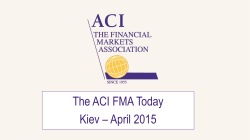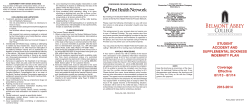
the ACI Response to ESMA Addendum
General information about respondent Name of the company / organisation Confidential 1 Activity Are you representing an association? Country/Region ACI Financial Markets Association ☐ Investment Services ☒ International Prepared on behalf of and by the ACI– The Financial Markets Association ACI - The Financial Markets Association (ACI FMA) is a leading non-profit but also a non-political association of wholesale financial market professionals contributing to the market development through education, market practices, technical advice. ACI counts some 13,000 international members from more than 68 countries This paper is the result of considered debate amongst the members of the ACI FMA appointed leadership and members, and is intended to provide our unbiased replies to the information provided in the MiFID/R - ESMA LEVEL 2 Consultation - Addendum Consultation Document on Transparency Requirements. The ACI FMA welcomes the opportunity to engage with the ESMA on this subject. The Consultative document, and the responses from the various market participants to the document, will help the regulators, industry participants and the public to be better educated on the structure and uses of derivative instruments in the financial market. The greater awareness that comes from this knowledge will assist the industry in assuring that best practices are followed. The members of ACI FMA are engaged with financial trading or sales environment in the global wholesale financial markets, representing a variety of asset classes including foreign exchange, interest rate products and other securities, banknotes, precious metals and commodities and derivatives. Therefore, unless otherwise specified, the ACI’s responses to this consultation with regard to transparency requirements apply to the FX derivatives and specific other derivative asset classes (CFDs, CDS) as addressed in the MiFID/R - ESMA LEVEL 2 Consultation - Addendum Consultation Document on Transparency Requirements. ACI The Financial Markets Association Response to ESMA Addendum-Consultation-Paper-MiFID-IIMiFIR 20 March 2015 1 Our response has been structured as follows to address our observations and key concerns regarding the methodology and interpretation of data for transparency evaluations and the definition of liquidity: General Observations FX Derivatives Spread Betting CFDs Credit Derivatives The ACI FMA would also express support for the initiatives and very comprehensive responses provided to ESMA by its fellow Trade organisations, AFME and ISDA with regard to the MiFID/R ESMA LEVEL 2 Consultation - Addendum Consultation Document on Transparency Requirements. General Observations Comments by ACI FMA’s global membership, their controlling institutions, which include bank and non-bank swap counterparties subject to or affected by EMIR, as well as their participant counterparties and customer base, reveals a number of common concerns. While the ACI FMA fundamentally supports the legislative goals and objectives that the MiFID/R ESMA LEVEL 2 Consultation on Transparency Requirements endeavours to achieve, the ACIFMA would propose caution in that liquidity standards and criteria introduced to fulfil these transparency objectives should not impact market liquidity through incorrect categorisation of illiquid instruments as liquid and vice versa. Transparency in the FICC markets does not necessarily equate to liquidity as is the case in the equity markets. Furthermore, liquidity determination methodology among FICC asset classes, sub-asset classes, instruments and currency pairs must, by virtue of the diverse nature of those market and product characteristics, be guided according to robust operational/historical market data collation. Additionally, the involvement of expert practitioner panels e.g. from trade organisations, Regulator/Central Bank panels, may be invaluable in defining specific market/instrument liquidity and accrediting liquidity threshold calculations and is to be encouraged. The ACI FMA would advocate that ESMA encourage involvement of expert practitioner panels from trade organisations or Regulator practitioner panels to ensure a robust outcome regarding the evaluation of FICC derivative market liquidity under the MIFID 2 regime. The cost of clearing related services, even those preparatory to market participation in instruments which have not yet been approved or made subject to mandatory clearing, are already rising, and are expected to rise further. Experience in other jurisdictions and under past regulatory modification regimes has demonstrated that two principled considerations must underlie every stage of regulatory reform, including the sourcing and analysis of the data upon which policy will be based. These are: (i) the cost/risk analysis of the compliance/avoidance decision across all categories of market participant, and (ii) the potential for regulatory arbitrage (see DFs vs NDFs) ACI The Financial Markets Association Response to ESMA Addendum-Consultation-Paper-MiFID-IIMiFIR 20 March 2015 2 Derivative products have been developed, predominantly by the ‘sell-side’ to provide ‘buy-side’ customers with risk management instrument for the purpose of hedging and investment. The ACI FMA is concerned that the potential for in-correct categorisation of derivative products as liquid may have undesired consequences for financial market participants on both ‘sell and buy-side’ and for the European financial markets overall. Our specific concerns in this respect are: The potential costly and onerous burden of additional transparency and Systemic Internaliser (SI) compliance requirements under MIFIR on “sell-side market participants’, which may have a detrimental impact on liquidity/reluctance to quote, therefore and causing shortages in particular currencies, securities or instruments or increase product cost An increase in systemic risk to corporate or institutional portfolios as customers are either reluctant to hedge/invest due to increased costs or with a reduced product offering, are forced to accept less than optimal hedging/investment instruments. With reference to the last point the recent increases in general FX market volatility illustrates the systemic risk attendant to under hedging by end users. As many smaller investment related businesses, such as private equity and multi-family offices, are swept into the definition of financial institutions, and many end users categorised as large non-financial counterparties based upon the ESMA data, the cost of cleared hedging will become, or appear, greater to them then the potential losses from unhedged alternatives. The cumulative systemic risk from such a result is self-evident. While, as mentioned, being supportive of the consultation objectives, the ACI FMA recognises the potential impacts and burdens (legal, technical, operational, etc.) of compliance with the on-going regulatory and legislative reform on market participants. Therefore, the ACI FMA would advocate prudence and consideration regarding the process for introduction of further regulation and would espouse a phased implementation approach. Regulators need to allow the full impact of the on-going regulatory initiatives/revisions and the ensuing changes to be absorbed by the global markets, in order to evaluate whether further intervention is necessary to capture hitherto unidentified risks and to prevent the emergence of new systemic risks and/or the disruption of existing, functioning markets and liquidity. ACI FMA Comment on Data Integrity (With reference to Q1,3 & 4 of the Consultation Paper) The ACI FMA’s observation with regard to the data collated in this Consultation Paper (CP) as representative of liquidity for the derivative markets covered in this CP is that the definition of liquidity as ascribed to each individual currency and cross currency pair is too arbitrary. Our concern is based upon the following: The data is derived from Trade Repositories (TR) gathered over a relatively brief period (3 months March-May 2014) of time after the introduction of mandatory trade reporting under EMIR. The tenors are based on a very protracted ‘snapshot’ of trade data, which may not represent/accommodate any trading anomalies or The data may contain compression trade data, which distorts liquidity thresholds as these are not price-predictive, market impacting trades The ACI FMA believes that it is important to frame the context of the ESMA’s data collection within the very brief period used in the Consultation Paper (CP). Under EMIR, unlike, for example, under the ACI The Financial Markets Association Response to ESMA Addendum-Consultation-Paper-MiFID-IIMiFIR 20 March 2015 3 Dodd Frank Act, the obligation for trade reporting and validation is incumbent on both parties to the transaction. For the FX asset class there are a number of Trade Repositories (TR) registered in the EU. Counterparty submission matching and validation is done via exception (or ‘miss-matching’) reporting. However, during the time frame used for the Consultation, due to the absence of any exception reporting, counterparties would not have been able to perform this validation test either intra or inter TR. Further multiple complications to the sample collected include: Double counting of mirror offset trades under prime brokerage and give up relationships Additionally, many counterparties were hindered in their reporting ability by: the absence of or delay in Legal Entity Identifier (LEI) provision, delayed processing of applications for multiple LEIs for certain counterparties and their affiliates and tardy reactivation of LEIs after their expiration as well as some as yet unquantified levels of general non-compliance. While netting is taken into account for threshold calculations at the individual counterparty level, it is unlikely that the absolute values of aggregate notional exposures in the ESMA data are robust, especially when the disparity to trade volumes is noted. The importance of high volume largely retail contracts such as currency spread bets and CFDs, which are overwhelmingly traded on an intraday basis, is likewise of deceptive relevance. The ACI FMA notes that the aforementioned data complications are not just applicable to the FX market data presented in the Consultation Paper, the data collection process and methodology will most probably have had a similar contra indicators with regard to(il)liquidity, Large In Scale (LIS) and Size Specific to The Instrument (SSTI) calculation thresholds. Given these noted complications during the data reporting period, we would propose that the data analysed and assessed in the Consultation cannot be an accurate representative sample of European trading from a standpoint of instruments, notionals, cash flow profiles and volumes traded. These issues of categorisation must be remedied before policy is based upon them. Therefore, the ACI FMA would propose that the quality and type of data used in the data analysis does not represent a robust -enough sampling, in most cases, to facilitate accurate determination of derivative product liquidity thresholds. This is of great concern to the ACI FMA as this data currently constitutes ESMA’s foundation for defining liquidity and calculating Large In Scale (LIS) and Size Specific to The Instrument (SSTI) thresholds. Therefore, based on the CP analysis of data, the ACI FMA cannot confirm agreement of ESMA’s definition/representation of liquid/illiquid markets. Furthermore, the ACI FMA believes that this model for assessing liquidity is too static. We would suggest a recalibration of data and model within the next 6 months and thereafter on an annual basis. Any recalibration (methodology) will need to incorporate/consider market/asset class/instrument impacts of the transparency regulation i.e. the effects that the introduction of the new EU transparency regime will have on the liquidity of the instruments. We would also propose that ESMA seek counsel on these ‘Effects’ by involving expert practitioner panels from trade organisations or Regulator practitioner panels. FX Market ACI The Financial Markets Association Response to ESMA Addendum-Consultation-Paper-MiFID-IIMiFIR 20 March 2015 4 With regard to the FX market: The global daily volume of the foreign exchange (FX) markets according to the Bank for International Settlements preliminary global results from the 2013 Triennial Central Bank Survey of Foreign Exchange and OTC Derivatives Markets Activity show that trading in foreign exchange markets averaged $5.3 trillion per day in April 2013. The transmission and exchange of currency is a fundamental financial activity that underpins the world’s economic and commercial system. The specific reasons behind each FX transaction are. However, the principal drivers behind FX activity can be regarded as: Commercial - payment for goods and services FDI - to effect foreign direct investment Derived from other financial markets activity i.e. purchase of foreign currency denominated assets – bonds or equities Hedging of portfolio asset ( currency) risk Direct investment in currencies The FX market is primarily an OTC market, which is de-centralised and geographically dispersed by nature with no dominant market venue and operates on a 24 hours basis through diverse time-zones circa 6 days a week. Transactions are bi-lateral, with prices discovered, indicated, quoted and trades executed by/on a variety of trading institutions, venues and electronic platforms – single dealer, multi dealer, retail and internet providers. Buy-side counterparties have access to a broad range of FX instruments (Spot, Forwards (DF & NDF), FX Options (vanilla, complex and exotic deliverable and NDO), currency pairs, maturities and counterparties; therefore enjoy substantial transparency in liquid markets. ACI Comment on FX Market Liquidity NDF vs DF (With reference to Q1 of the Consultation Paper) For many of the cross currency pairs illustrated in the Consultation, liquidity can be and is arrived at by trading the component parts so that the volumes in the actual iterative crosses are not representative of the total prospective liquidity. Zone differences make a sizeable difference to the criteria. For example, whilst there might be consensus the USD CLP is a liquid currency that is surely only the case when Latin America is open. However, the data captured for the MiFID/R - ESMA LEVEL 2 Consultation on Transparency Requirements is, of necessity, European market centric. Therefore, while the liquidity framework may seek to describe only the liquidity of the EU portion and segmentation of those markets, it appears potentially to demonstrate a percentage of the market in the European time-zone, rather than the liquidity available. Furthermore, according to the Bank of International Settlements (BIS) 2013 Triennial Central Bank Survey, NDFs constitute only a fifth of the global foreign exchange market in outright forwards and a tiny fraction of overall foreign exchange trading. In fact, NDF volumes at just $127bn/day, represent about 2.7% of the $5.3tn total global FX volumes based on BIS 2013 Triennial FX Survey data, with London accounting for some $43bn/day which is about 34% of NDF trading. The Bank of England Survey 2014 indicated that NDF volumes amounted $55bn/day versus $1398bn/day of DFs (swaps+ outright forwards). It should be noted that ESMA referenced the BIS data in the November, 2014 Consultation on Mandatory Clearing for NDFs. The ACI FMA further notes that in the introduction on pages 15/16 the percentage of trades deemed as forwards and swaps in deliverable currencies looks much too low against the NDF data. Also, we see no evidence that the analysis has taken data such as the number and type of market participants, ACI The Financial Markets Association Response to ESMA Addendum-Consultation-Paper-MiFID-IIMiFIR 20 March 2015 5 as well as the average size of spreads into consideration when discerning liquidity. In comparison, the CP data differs radically from the data illustrated in both the BIS and Bank of England surveys of 2014 mentioned above. The inference from the ESMA Consultation data is that the Non-DeliverableForwards (NDFs) market is significant in size, whereas it actually represents approximately 4% of nonspot markets (Bank of England Oct 2014 Semi-Annual FX Survey). Therefore the ACI FMA would advocate that NDFs, per se, be categorised as illiquid. Further consideration of the FX data tables presented in the Consultation paper, revealed a number of anomalies, which are of concern to the ACI FMA: Inclusion of non-deliverable currency crosses within the DF bucket e.g. CNH/USD, EUR/RUB, INR/USD as well as a large proportion of instruments that typically are not deemed liquid (e.g. non-USD crosses) in the normal course of trading have been categorized as liquid by ESMA. In particular, we note that, under Table 48 of draft RTS 9 (FX NDF Liquid Classes), COP-USD pair with a tenor from 4 days to 7 days is considered liquid and the Large-In-Scale (LIS) thresholds are set at a €700 million, which is greater than the average daily volume for that market. The ACI FMA would propose that some LIS thresholds need re-calibrating/re-consideration as they appear unrealistic. (see below). Alternatively the calibration methodology needs revision? Inclusion of precious metals in the analysis, particularly for Foreign Exchange (FX) derivatives. For example, under Table 48 of draft RTS 9 (FX NDF Liquid Classes) USD-XAU is included as a liquid class of NDFs. The XAU symbol is representative of Gold, which is not a currency, rather a commodity. Therefore, we would suggest that contracts relating to precious metals should, for good order’s sake and in order to avoid any duplication of regulatory treatment, be included in the ESMA assessment of Commodity Derivatives. Inclusion of deliverable currency crosses within the NDF category, which rarely or never trade as non-deliverable forwards – therefore categorising them as illiquid A consideration for the inclusion of deliverable currency crosses within the NDF category is the potential for regulatory arbitrage. Regulatory reform is rendered moot where market rules can be easily avoided by the substitution of economically identical unregulated transactions. Multiple possibilities are demonstrated in the data presented. Some of these are of a ‘plug and play’ nature, such as the substitution of spot or deliverable forward currency pair transactions for NDFs. This is a simple adjustment for the many contracts in underlying deliverable major currencies, such as AUD/JPY, which counterparties elect to trade on an NDF basis. The ESMA report data on NDFs reveal that a substantial percentage of contracts that are categorized as liquid NDFs fall within this category, and the majority of those in the 1 to 3 month maturity range. Not only could NDF clearing requirements be easily avoided by reliance on the much more liquid existing spot or deliverable forward market for such pairs, but the inclusion of these contracts in the data introduces considerable distortion in the calculation of threshold volumes. This is especially of concern because the users of such ‘elective ‘NDFs tend to be non-financial counterparties, who are doing so for hedging purposes. ACI FMA comment on FXO (With reference to Q1 of the Consultation Paper) ACI The Financial Markets Association Response to ESMA Addendum-Consultation-Paper-MiFID-IIMiFIR 20 March 2015 6 From the BIS 2013 Triennial Central Bank Survey, it is proposed that FX options represent 9% of the total market volume and 13% of the UK FX Market (BoE Oct 2014 Semi-Annual FX Survey), of which, according to market intelligence, FX complex exotic options, represent approximately 2% of the FX market. The ACI FMA’s observation is that FX Options, whether exotic or generic, should be regarded as illiquid. Concentration of Liquidity by Maturity With regard to the tenors and transaction maturities, analysis of the BIS Data, as contained within the ESMA Consultation document on Clearing of NDFs of November,2014, confirmed that for all currencies, deliverable or otherwise, the turnover was concentrated for contracts with a maturity below 1 year. The average turnover across currencies of FX forward contracts with a maturity above 1 year was 4.7%. Additionally, the November 2014 Consultation documentation referenced analysis of DTCC data (NDF only). This dataset revealed that the liquidity was concentrated on the shortest maturities. For all currencies except CNY, 90% of the contracts in the sample had a maturity below 3 months, 98% of the contracts in the sample had a maturity below 6 months. The share of contracts with a maturity above one year was around 1%, again with the exception of CNY where it reached 2.8%. Using the BoE October 2014 data, the liquidity concentration is focussed in the 1-6 month bucket, whereby the BIS data presents a maturity bucket of >7 days < 1 year. However, whilst difficult, and subject to considerable debate, a more simple criteria of what is or is not a liquid currency is a recommendation based on market intelligence from and discussion with the ACI members. We would propose the following for the determination of maturity vs liquidity - all major currencies against the US$ and Euro up to one year and all minor currencies against the US$ up to 6 months (with minor Europeans against the Euro also) would appear to encapsulate what is trying to be achieved by this CP. Additionally, The only other definition is that for minor currencies and/or NDFs the definition of liquidity would only encompass the times those centres are open. Additionally, we would propose that notional amount per day should be increased significantly from 500 million EUR to circa 5 billon EUR. It should be noted that Table 1 on page 17 of the CP confirms that the notional amount per day well exceeds the suggested 500 million EUR and therefore there is the potential of categorising some instruments as liquid, which are actually not liquid. Moreover, as mentioned previously, FX OTC (derivative) trades can be executed (24/6) at any time and are thereby not restricted to certain trading hours or days. ACI FMA Comment on – LIS/SSTI (With reference to Q 2 & 5 of the Consultation Paper) With reference to the CP data, the ACI FMA notes that there are significant differences in LIS thresholds between currency pairs and tenor buckets, which is attributable to the complications ESMA has experienced in calibrating the data. For example, as mentioned previously, regarding NDFs the COP-USD pair with a tenor from 4 days to 7 days is considered liquid and the Large-In-Scale (LIS) thresholds are set at €700 million, which is greater than the average daily volume for that market, which is, therefore, obviously erroneous and requires amendment. It is also of concern to the ACI FMA that the SSTI threshold has been set at 50% of the LIS threshold as opposed to any other percentage, which appears to be quite an arbitrary level . The SSTI and LIS are different thresholds with different intended objectives. The SSTI threshold is to protect liquidity providers and Sis’ from ‘undue risk’. After much consideration, we believe that it would be more ACI The Financial Markets Association Response to ESMA Addendum-Consultation-Paper-MiFID-IIMiFIR 20 March 2015 7 appropriate if LIS/SSTI thresholds were set at a level appropriate to the liquidity (or illiquidity) of each instrument i.e. LIS/SSTI threshold should be adjusted to reflect local market conditions (SSTI= median trade size or as lower percentage to LIS), rather than a ‘one size fits all fixed threshold’ within the EU. Failure to rectify this could potentially impose costly and onerous burdens of additional transparency and Systemic Internaliser (SI) compliance requirements under MIfir on ‘sell-side market participants’, which could then have a detrimental impact on liquidity/instigate a reluctance to quote. This could cause shortages in particular currencies, securities or instruments or increase product cost for customers. LIS/SSTI deferral period set to 48 hours (With reference to Q 2 & 5) The ACI FMA would express agreement regarding a minimum deferral period of 48 hours for transactions that are equal to or exceed LIS or transactions equal to or above the SSTI threshold. However, we would propose that this should actually be expressed as T+2 (business days) to accommodate transactions done with counterparties at close of business before the weekend or before national holidays to ensure adequate time for market risk mitigation of large or illiquid transactions on the part of the market makers. However, with regard to transactions that are both LIS and illiquid, this time deferral may not be adequate. Therefore, the ACI FMA would urge prudence and caution and counsel that a longer deferral period may be considered. A further point of consideration, which the ACI FMA would advocate and encourage, is that there should be a pan-EU adoption/harmonisation by National Competent Authorities (NCAs) of the supplemental volume omission deferral regime. Summary In summary, the ACI FMA would counsel cross-reference to and co-operation on the part of ESMA with the Bank of International Settlements (BIS) or Bank of England (BoE) (Survey data) in order to verify and underpin the integrity of the data collated and to facilitate a more accurate representation of the FX Derivative market distribution with regard to instrument and currency pairs. Additionally, we would suggest that ESMA enlist the involvement of Regulatory and trade organisation expert panels to ensure a robust outcome regarding the evaluation of FICC market liquidity. The ACI FMA would be happy to assist ESMA in this respect as a number of our members sit on such panels. Spread Betting and Contracts For Difference (With reference to Q9 of the Consultation Paper) The ACI notes that this has been included as an asset class; however, we would propose that spread betting should neither be categorised as an asset class nor an instrument, rather a transaction type or method. To this effect we would reference footnote 25 on page 210 of the CP, which states ‘this code is not provided for by the legislation’. Therefore, this category should not be included within this FX section. However, an appropriate treatment and categorisation of spread betting is to be encouraged. Therefore, the ACI FMA would suggest that transaction of this nature should be categorised according to the nature of the underlying instrument. The same concerns regarding data distortion/confusion exist with respect to spread bets and Contracts For Difference (CFD’s) on currency pairs, which ironically themselves came into existence as a regulatory arbitrage to avoid stamp and/or capital gains taxes in some jurisdictions. While it is not clear how CFDs have been categorized in the data, this largely retail version of the Total Return Swap constitutes one of the fastest growing market instruments on a volume basis ex-U.S. Both ACI The Financial Markets Association Response to ESMA Addendum-Consultation-Paper-MiFID-IIMiFIR 20 March 2015 8 currency pair CFDs and currency spread bets could also be easily substituted with Spot contracts, in many cases with a simple mouse click on the same ECN platform. Similar issues have already been demonstrated in other classes of clearable derivatives. The most liquid IRDs can be easily replaced by banks with matched loan agreements. From market intelligence we know, that CFD issuers are already looking hard at major insurers to provide default policies or other forms of contractual guaranty that fall outside of banking and derivatives regulation in many jurisdictions. While regulatory arbitrage will always be a feature of any rules based regulatory system, where clear workarounds to the Level 1 legislation already suggest themselves at the public comment stage, this issue must be considered. In the context of the CP, the term CFD is very expansive and may actually capture a broad number of other derivative contracts. Therefore, for good order’s sake, it would be appropriate that the definition be amended to exclude other derivative contracts and reflect that a CFD would be labelled as such to avoid duplication of regulatory categorisation. Credit Derivatives (CDS) – Single Name, CDS Index, CDS index options (Q3 & Q4) With regard to the data presented in the CP for the Credit Derivatives category and while appreciating the variety of and differences between the various derivative asset classes covered under the CP, the ACI FMA is of the opinion that the CDS data, per se, is beset with similar problems to the FX data with regard to definition/categorisation of (il)liquidity, Large In Scale (LIS) and Size Specific to The Instrument (SSTI) calculation thresholds, by virtue of the ESMA data gathering methodology . As noted previously there is no evidence that instrument maturity, cash flow and volumes traded have been taken into account, much less market participant and product spread have to be considered when conducting the ESMA analysis. We would refer ESMA to our comments on page 6, paragraphs 2-3. Additionally, we would comment that, based on feedback from our members, liquidity thresholds across the credit derivative classes should not necessarily be the same. Nevertheless, we would make specific mention of the following concerns in addition to those expressed earlier in this consultation response. Single Name CDS ESMA has undertaken an extensive liquidity analysis of derivatives classes. Multiple sub-classes have been analysed and categorised as liquid or illiquid. Nevertheless, the sub-divisions of the asset class does not appear to offer sufficient granularity e.g. single-name CDSs are defined by ‘underlying issuer type’ and as per this analysis single-name CDSs denominated in Euro and US Dollar up to 5-6 years are considered as liquid. However, this is somewhat misleading as corporates or sovereign entities have differing liquidity characteristics. Therefore, further clarification and classification is desirable to identify the correct issuer of the underlying bond or loan as well as a taxonomy, which should include at a minimum of details of region, currency, tenor and coupon. Furthermore, distinction regarding ‘tranched’ and ‘untranched’ would be desirable. Another measure of liquidity under ESMA, which is of concern to the ACI FMA is the determination that in order to be liquid an instrument must trade more than once or twice per day for CDS Single Name this equated to two trades/day. However, in our opinion this threshold is too low and a minimum of 10 times per day with a notional threshold EUR 500 million of would be more ACI The Financial Markets Association Response to ESMA Addendum-Consultation-Paper-MiFID-IIMiFIR 20 March 2015 9 appropriate to determine liquidity in combination with the previous proposal regarding enhanced granularity. CDS Index and CDS Index Options Our liquidity concern with regard to CDS indices and CDS index options is that a liquidity classification, similar to the previous concern regarding CDS single names, appears to have been made based on a low absolute trade turnover with regard to the notional amount and frequency of trade i.e. trades once or twice per day. (Proposal is once per day for CDS Index and twice per day for CDS Index Options). Based on feedback from ACI FMA members, the ACI FMA regards that a minimum 2400 trades a year or 10 trades per day and a notional threshold of EUR 10 million for CDS index and 200 million for CDS single names would be a measure more reflective of a liquid market in these particular instruments. Therefore, would advise that this liquidity measurement should be revisited to avoid classifying illiquid instruments as liquid. The ACI FMA would agree with the ESMA categorisation of bespoke basket CDS and single name CDS options as illiquid. Summary The ACI believes that the Consultation document, and the responses from the various market participants to the document will help the regulators, industry participants and the public to be better informed regarding the MiFID/R - ESMA LEVEL 2 Consultation - Addendum Consultation Document on Transparency Requirements. The greater awareness that comes from this knowledge will assist the industry in assuring that best practices are implemented and followed. The ACI thanks ESMA in advance for its consideration of the views we have expressed in this Consultation response. We look forward to working with ESMA. www.acifma.com ACI The Financial Markets Association Response to ESMA Addendum-Consultation-Paper-MiFID-IIMiFIR 20 March 2015 10
© Copyright 2025









